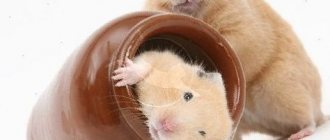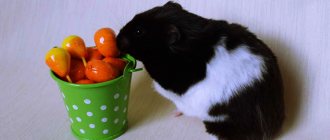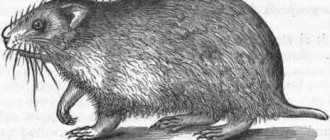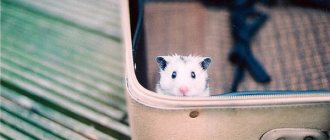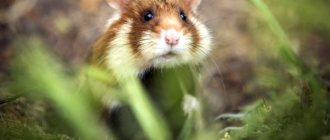- Wild animals
- >>
- Mammals
The Djungarian hamster is a small, very cute and active animal from the rodent family. They are very common as pets. Their popularity is explained by their simplicity and low maintenance requirements. However, before you bring such a small animal home, you need to ask how to properly create comfortable living conditions for it. In many literary sources, the dzhungarik is found under the name Sungur hamster.
Origin of the species and description
Photo: Djungarian hamster
Djungarian hamsters are chordates. They are classified into the class of mammals, the order of rodents, the family of hamsters, the genus of hairy-footed hamsters, and the species Djungarian hamster. The first scientific description of hamsters was compiled in 1839 by researcher Waterhouse. At that time, these representatives of the hamster family were present in single specimens only in the territory of modern Syria.
Almost a hundred years will pass until the first living hamster falls into the hands of scientists and researchers. The first person to catch the rodent was the scientist and researcher Aharoni from Jerusalem. He managed to find a female specimen in a deep hole along with 12 cubs.
Video: Djungarian hamster
After transporting the animals, only four were able to survive. Very soon, offspring appeared from these animals, which also began to multiply and produce offspring quite quickly. It was these individuals, discovered by the professor in a deep hole, that became the ancestors of all animals kept at home.
In 1938, the animals were brought from England to the United States. Here they were used as animals for laboratory research. Then they returned to Europe as laboratory animals. From this point on, the rapid and highly successful domestication of animals began. Within about a decade, hamsters have completely become pets in many countries around the world.
Life expectancy and illness
The health and lifespan of a hamster depend on heredity, living conditions, a balanced diet and the attentiveness of the owners. How long do Djungarian hamsters live? Under ideal conditions, a hamster can live up to four years. The average lifespan is two years.
Quite often, rodents receive mechanical injuries while walking. Hamsters do not have a sense of height, so they are able to jump from their hands even from very high heights, which can cause the animal to be seriously injured or die. Running wheels with a sparse grid or large mesh are dangerous. The animal's paw can get stuck while running, which can cause bruises and fractures.
Running balls are dangerous for hamsters. They can only serve as entertainment for the owner, but not for the animal itself. While running, the hamster constantly crashes into walls and various objects. In addition, while running in a ball, the hamster overheats, he lacks oxygen, which is why he may well get a heatstroke and die.
Other pets are no less dangerous for hamsters. If dogs are able to simply throw off the cage, then cats can reach the hamster with their claws through the bars. If there are cats at home, it is better to keep the hamster in a plastic container or a Dune-type cage that has solid plastic walls.
Due to their genetic proximity to Campbell's hamsters, many dwarf hamsters are predisposed to diabetes. The main symptom of the disease: the rodent drinks a lot of water often. You can check your suspicions using a test purchased at a regular human pharmacy.
Caring for a Djungarian hamster with diabetes differs only in its diet. The rodent should not be given any foods containing sugar. This is the only way the animal can live longer. The absence of a running wheel in the cage can lead to obesity, and then to heart and liver problems in the dwarf.
Appearance and features
Photo: What a Djungarian hamster looks like
Djungarian hamsters are very cute small animals that have a pointed muzzle and small, round ears. Sexual dimorphism is practically not expressed. One adult, regardless of gender, has a body length of 9-10 centimeters. The body weight of one adult individual is about 35-65 grams. The animal's muzzle is slightly elongated, pointed at the nose. Hamsters' eyes are round, black, and shiny. The nose area is framed by a rather long mustache.
Hamsters' fur is quite thick and can be colored in a variety of colors. The body of rodents is painted in two colors. The upper part of the body in the back area has a darker color. The paws and belly area are colored light, milky or beige. A characteristic feature is the presence of a dark stripe that runs along the line of the animal’s spine.
Possible color options for rodents:
- grey;
- brownish;
- gray with a lilac tint;
- ginger;
- cream.
Under natural conditions, hamsters shed twice a year. In winter, their coat is white with a silver tint, and in summer it turns gray for camouflage purposes. Hamsters have small, four-toed feet. They perform the function of hands. The fingers have long, sharp claws that help animals when digging holes. The animals' fingers are covered with thick fur. Djungarian hamsters have a thin, short tail.
Cover
Includes a description of the hamster's fur. The coat is soft, short and very thick. Gives the animal volume and smooth lines of the body and head. The legs including feet, tail and ears are covered with shorter and sparse hair.
Flaws
Sparse, uneven, wrinkled coat. The ears, tail and paws are not covered with hair.
Vices
Large areas of the body without hair.
Where does the Djungarian hamster live?
Photo: Djungarian hamster in Russia
The natural habitat of the dwarfs is quite wide. Djungarian hamsters are named after a province in the northwestern region of the People's Republic of China - Dzungaria.
Geographical regions of animal habitat:
- desert regions of Russia;
- Altai region;
- Kazakhstan;
- Mongolia;
- China;
- Korea.
The animals live in minks. The burrows are dug and arranged independently. Each burrow has from 3 to 6 entrances and exits. The structure of hamster burrows resembles real chambers, the depth of which is about one meter. The rodent has a pantry room where it prepares food supplies for the winter, a bedroom, and a latrine.
To keep an animal in artificial conditions, you will need a cage, which must be equipped with everything you need to keep a hamster comfortable. A wheel with a diameter of at least 16 centimeters must be placed in the cage. A wheel with a small diameter leads to spinal deformation. Another mandatory element is a house. It is better if it does not have large window openings to avoid an animal with cheeks full of food getting stuck in it.
It is necessary to put branches of fruit trees and shrubs in the cage, on which the hamster will sharpen his teeth. You need to designate a toilet for him in some corner. From time to time it is recommended to place a container in the cage into which sand can be poured for chinchillas. Djungarians will happily swim in the sand in this container. It is prohibited to place cotton wool, hay, or various scraps of fabric into the animals’ homes. Long fibers can crush the limb. In this case, it dies.
How to weigh a hamster?
To weigh this tiny creature you will need:
- kitchen scales;
- cardboard or plastic box;
- seeds or nuts;
- the hamster himself.
First you need to weigh the box itself with several seeds, then put the animal there and use the subtraction method to determine the weight of the animal itself.
The seeds are needed so that the hamster is occupied with them for the time required for weighing, otherwise the fidget may run away.
Reasons for changes in hamster weight
What does the Djungarian hamster eat?
Photo: White Djungarian hamster
Djungarians are undemanding when it comes to nutrition, so keeping and feeding them will not be too expensive. This type of pet can safely be called omnivores. The best option for these animals is ready-made balanced types of food specifically for hamsters. The basis of these feeds are granules and grains and cereals. Hamster formulas also include pieces of corn, as well as at least 10-15% proteins.
Be sure to give your hamsters fresh, juicy vegetables and fruits, which the animals love very much. However, it is necessary to promptly remove unused remains and cells in order to avoid rotting and disease of the animals, since animals often not only eat the food allocated to them, but also hide large quantities of them in their cheeks. This is how they stock up on provisions.
The owner must ensure constant access to water. To do this, you can install sippy cups. Another mandatory condition is the introduction into the diet of vitamins and minerals necessary for the normal functioning of hamsters. The animals also need to be fed with fresh herbs and juicy berries. Sometimes it is recommended to give them nuts and sunflower seeds. Hamster breeders should be careful about the source of protein in their hamsters' diet.
It is recommended to give them the following ingredients as protein food:
- boiled chicken liver in small quantities;
- boiled chicken breast;
- low-fat varieties of cottage cheese.
Your hamster should have fresh food every day. Changing the water in the sippy cup is also required daily. It is strictly forbidden to include foods that contain large amounts of sugar in your diet.
Syrian breed of hamsters
Owners should think in advance about how much a Syrian hamster weighs, since it is much larger than a dwarf hamster.
An adult furry pet can reach a size of about 19 cm and is a fairly large representative of its family. The animal loves to communicate with people and is willing to be held.
Such a pet weighs 100-200 grams. It is typical for this breed to have both long and short hair. Best for a hamster:
- Housing size 40*60 cm.
- Treadmill with a diameter of 18 cm.
- Living without neighbors.
Features of character and lifestyle
Photo: Djungarian hamster
Djungarian hamsters tend to lead a solitary, solitary lifestyle. Under natural conditions, they live separately, in burrows that they dig and inhabit on their own. Rodents tend to be nocturnal. During the day they sleep almost all the time, hiding in their shelter. The shelter is left at nightfall. This way of life allows you to hide from a large number of enemies in natural habitats.
At night, hamsters are very mobile and active. In search of food in natural conditions they can travel quite long distances. A distinctive feature of these representatives of rodents is their thriftiness. Animals tend to collect food with their paws, like hands, and push it behind their cheeks. So they bring it home and put it in their storerooms.
Interesting fact: The size of the cheek space in which animals store their reserves can exceed the size of their heads by three times. It is noteworthy that before the onset of cold weather, hamsters can make an amount of reserves that exceeds their own body weight by almost a hundred times!
It is at night that animals are engaged in searching and collecting food and arranging their burrows. They also tend to frolic, just run and play. That is why, when arranging a cage for keeping at home, it is very important to install a wheel, swings, etc.
Typically, each individual has its own habitat region, and the territories of different individuals do not overlap. In a situation where this does happen, individuals reclaim their territory from each other. Often such wars lead to the death of the weaker animal.
Care and maintenance at home
The natural habitat of Djungarian hamsters extends to semi-fixed sands, as well as gravelly-cinquefoil, wormwood, grass-desert and xerophytic zones of the steppes of North-Eastern Kazakhstan and Central Asia, including the territory of the central regions of Asia, as well as the Western Siberian District.
Therefore, the conditions for keeping this animal in captivity should be as close as possible to natural ones. Maintenance experience shows that Djungarian hamsters, despite the ease of maintenance, still require competent and constant care.
How many jungarians to have?
According to experts, it is permissible to keep only one animal in one cage, regardless of gender. This is due to the fact that these animals are quite territorial and in limited space, capable of showing aggression towards each other.
As a result of keeping several animals in one area, they develop a feeling of permanent stress. In this state, they are capable of inflicting injuries on each other, sometimes incompatible with life. Therefore, each animal purchased for the purpose of further maintenance must be housed in a separate cage.
Selecting a cage and filling it
Keeping Djungarian hamsters at home does not involve any special problems; it is enough to choose the right cage and fill it correctly. The most suitable cage for this small animal may have dimensions of 300x500 mm. A special cage made of transparent plexiglass is also suitable. The pet's cage must contain:
- Bedding in the form of finely sifted sand or medium-sized compressed sawdust. These materials are quite cheap, but at the same time they perfectly absorb moisture and also absorb unpleasant odors. It is not recommended to use cotton wool, paper napkins, newspapers, rags, etc. as bedding.
- Special toilet for keeping small domestic rodents. Special absorbent components are poured into such trays. Typically these are called fillers.
- Holes that can represent various roots, plant branches and tubes.
- Holiday house. This can be the most primitive structure made of wood or other environmentally friendly material.
- A wheel with transverse protrusions and without a grid in the bottom.
A wide range of similar and other accessories are sold in pet stores. The main thing is that there are enough of them, but not too many. A convenient drinking bowl and feeder must be present in the animal’s cage; a drinking bowl with a volume of about 50 ml is sufficient. It is necessary to ensure that the water in the drinking bowl is changed daily. The feeder should have standard sizes, depending on the size of the animal.
It is important to know! It is not recommended to keep these animals in aquariums with high walls, since the space inside them is poorly ventilated. Therefore, the internal surfaces often fog up, which negatively affects the health of jungarians.
When filling an animal's cage with various accessories, one should not forget about a special stick or mineral stone. They are necessary so that the animal can grind down its teeth. A twig of any fruit tree, with the exception of apricot and cherry, is suitable as a stick.
Social structure and reproduction
Photo: Djungarian hamster in nature
Djungarian hamsters are highly fertile. This is how nature intended it so that the animals would not hatch in their natural habitat. Hamsters reach sexual maturity at four weeks of age. If the animals are kept at home, they should be separated from each other as soon as they are one month old. Early pregnancy is very dangerous for the life and health of females.
The most optimal age for the first pregnancy is 3.5-4 months. After mating at home, individuals of different sexes are recommended to be separated so that they cannot harm each other. Pregnancy lasts on average 23-24 days. One female can give birth to from 1 to 10 cubs. Babies are born completely helpless and are in great need of maternal help and care. Sometimes it happens that the female abandons her offspring, or may even eat her cubs.
Interesting fact: A day after the birth of her offspring, the female is again ready to mate.
Hamsters get stronger and grow quite quickly. To get healthy offspring, it is recommended to choose healthy individuals with a known pedigree for mating. Only in this case is there a guarantee that the animal will not have any pathological diseases.
Weight and size of hamsters of different breeds
Anyone who wants to have a pet needs to know its weight and size, because when purchasing an animal, it is necessary to take them into account for:
- For the future home, it is very important to choose a cage so that it does not confine the animal;
- All accessories are selected according to size (wheel, hammock, shelves, etc.);
- Possibility of living together;
- Amount of feed required.
The hamster's weight should be monitored for comparison with normal levels to know whether the animal is developing normally. Hamsters are already considered fully formed at 6 months, and at one and a half years they begin to age: during this period, weight loss is noted, and this is considered the norm.
Natural enemies of Djungarian hamsters
Photo: What a Djungarian hamster looks like
In their natural habitat, hamsters have a huge number of enemies who constantly hunt them. The nocturnal lifestyle and deep burrows save rodents from some of them.
Natural enemies of hamsters:
- predatory bird species - stoats, owls, hawks, falcons;
- ferrets;
- wild dogs;
- foxes;
- wolves;
- lynx;
- wild cats;
- martens.
Nature has endowed these representatives of the rodent family with excellent hearing, which allows them to detect the slightest rustle at a considerable distance. This ability allows you to determine the approach of an enemy in many situations. If a hamster hears dangerous sounds, it instantly flees. They most often hide in deep holes or other reliable shelters. If the sounds that instill fear are very close and there is no way to escape, the animal simply freezes, wanting to remain unnoticed. If this maneuver does not bring the desired result, the hamster rushes to attack.
In some cases, even large predators are confused by this behavior, giving the small animal a chance to escape. There are a number of diseases to which hamsters are very sensitive. Among the most common diseases that cause death in animals are diabetes and obesity.
Siberian breed of hamsters
The Siberian breed of hamster typically lives in the vast expanses of Siberia, where it can be found in its natural environment.
In appearance it is similar to the dzhungarika, and differs from them only in the color of its coat, which has a gray tint, and in winter it takes on a white color. This feature is interesting to study when animals live at home.
If owners are wondering how much a Djungarian hamster and its Siberian relative weigh, then the answer is quite simple. Since the weight of both of these representatives varies from 40 to 50 grams, Siberian hamsters grow to no more than 8 cm. For their maintenance, exactly the same conditions can be organized as for Djungarian hamsters.
Common hamster (wild)
The weight of the common hamster is greater than all other breeds. Because of its size, it is not a frequent guest in homes; it is more convenient to keep small hamsters.
The body length of an ordinary hamster reaches 30 cm. It is a tailed animal, and the tail is quite long, from 5 to 8 cm.
common hamster
This hamster is a big fan of “home comfort”; its burrows consist of many corridors, storage rooms and exits. Sometimes in the storerooms of such a hard worker you can find reserves of up to 15 kg.
How much does a hamster weigh
Even a non-professional breeder can breed wonderful fluffy hamsters. Before you become the owner of this little friend, you need to decide on the breed, since this determines how much the hamster weighs.
The parameters of a pet are very important, as they affect such nuances as:
- The size of the future home.
- Accessories for the cage, such as a wheel, mazes and more.
- Amount of feed consumed.
- The presence or absence of neighbors.
